It’s animals vs. humans near Yellowstone National Park
The summer traffic jams in the country’s premier national park are worst when a grizzly bear is foraging for berries in an open ditch, or a herd of bison is crossing the road, or elk have gathered on a river’s edge. Brake lights go on, and families huddle outside their cars in awe.
But a swift glance at these majestic animals does not reveal the complexity of the ecosystem in the park. Nor does it reveal the fragility of the futures of many of these creatures or the escalating conflict between the animals of Yellowstone and the people who visit them or who live in surrounding states.
Grizzly bears, for example, were removed this spring from the endangered species list after their numbers in the park began to soar. But the bears have begun to wander outside the sanctuary of Yellowstone, rifling through trash cans and occasionally attacking residents, prompting state officials in Wyoming, Montana and Idaho to consider allowing trophy grizzly-bear hunting for the first time in three decades.
Cutthroat trout, native to the region, are at their lowest population in centuries as non-native trout have entered park rivers. The new trout killed off millions of cutthroat trout, in turn causing the park’s populations of species that feed on the fish -- such as ospreys -- to decline at “staggering” rates, according to the park’s top bird expert.
Bison, a symbol of the American West, are flourishing in the park but increasingly roaming far beyond it. Now a recent outbreak of a bacterial disease common in bison has cattle ranchers fearful that the bison could contaminate their herds.
And, perhaps most contentious of all, gray wolves, once virtually extinct in America’s West, were reintroduced to the park -- and thus the region -- in the mid-1990s. They are doing well enough to be on the verge of removal from the endangered list, but the potential delisting has ignited a bitter debate between beef ranchers and conservationists about how to simultaneously protect livestock and expand the wolf population.
“You have to take a holistic approach to conservation when it comes to Yellowstone,” says Craig Kenworthy, conservation director for the Greater Yellowstone Coalition. “Because literally everything is interrelated.”
If nature is a circle, nowhere is it more apparent than places like Yellowstone this summer.
The gray wolf’s influence
For the first time in decades, aspen and willow trees are making a comeback in a park long dominated by pines. Many biologists attribute it to the gray wolf, because elk -- one of the wolf’s favorite prey -- are increasingly reluctant to venture into open spaces to munch on the tasty tree shoots. As the new trees grow, so have songbird populations.
“The gray wolves are doing very, very well,” said Doug Smith, the head of Yellowstone’s wolf reintroduction program. Smith cited not just the revival of certain trees but the fact that grizzly bears benefit by stealing some wolf kills and that overly large elk herds have been brought back down to healthier sizes.
The gray wolf is getting a less enthusiastic reception from two groups who see the comeback as anything but beneficial. Hunting outfitters in the states Yellowstone touches -- Wyoming, Montana and Idaho -- say wolves are decimating elk, the trophy game their high-paying clients most want to shoot. Ranchers say livestock kills from wolves are soaring, and the costs of protecting their herds are becoming untenable.
“You used to have to ride herds once every couple weeks to check in on them,” said Jay Bodner, natural resources director for the Montana Stockgrowers Association. “But since the wolf population has increased so dramatically, you’re seeing folks have to hire people to ride almost every day in an effort to protect their herd.”
Once delisting comes to pass, states, rather than the federal government, will be charged with managing their wolf populations. But that has led to debates about how wolf hunting seasons might be handled, whether ranchers would be allowed to shoot wolves out of season to protect their cattle, and whether there should be federal compensation to ranchers who lose stock to the wolves the government reintroduced to the park.
Many residents in the region fear that another natural snowball effect may bring danger to their back yards. Due to the protection offered by the park, the grizzly bear population has soared from just 200 bears to more than 600 in recent decades, as their coveted source of food -- cutthroat trout -- has plummeted.
It is expected the grizzlies will begin roaming outside the park to hunt for trout, and man-versus-bear conflicts are likely to follow. This spring, a man was mauled in the park by a grizzly; he survived, but game officials felt they had no choice but to hunt and kill the dangerous bear.
Few local governments around Yellowstone have laws in place that address the bears, but a handful of municipalities are starting to set examples, mandating bear-proof garbage containers and outlawing the planting of fruit trees or the stocking of ponds with fish, both of which would attract bears.
A grass shortage
The massive bison synonymous with Yellowstone have become the latest source of contention in the region around the park. Yellowstone is in the midst of a 10-year drought at the same time the park’s bison population is at one of its highest levels.
With not enough grass for grazing, the bison are wandering outside the park, grazing on cattle ranchers’ property and potentially exposing their livestock to brucellosis, a disease that causes pregnant cows to abort.
Bodner argues that the bison herds at Yellowstone have grown too large; he believes this year’s count will reach nearly 5,000. He proposed that hundreds -- or more -- be killed or moved from the park, a move that would still leave thousands of bison in Yellowstone.
“Listen, I appreciate that park too,” Bodner said. “I’ve gone up there three, four, five times already this year. But we have to find a way for the park and the rest of the region to co-exist.”
- - -
Yellowstone’s intricate web
*Gray wolf: Once virtually extinct in the lower 48 states, the gray wolf has been reintroduced with incredible success -- and controversy -- in Yellowstone.
*Grizzly bear: An endangered species until this spring, the grizzly has increasingly been wandering from the sanctuary of the national park whose protection has allowed its population to rebound.
*Cutthroat trout: Historically the fish found in Yellowstone’s waters more than anywhere else, this trout is seeing its numbers decline at an alarming rate because of an invasion of non-native species of trout.
*Bison: With soaring populations, the bison have become incorrigible, wandering from Yellowstone and angering the cattle ranchers of the region.
*Osprey: Illustrating how so much is interconnected in Yellowstone, these birds are seeing their numbers in the park plummet as their favorite meal -- cutthroat trout -- struggles.
Comments? Email travel-feedback@latimes.com
More to Read
Sign up for The Wild
We’ll help you find the best places to hike, bike and run, as well as the perfect silent spots for meditation and yoga.
You may occasionally receive promotional content from the Los Angeles Times.






